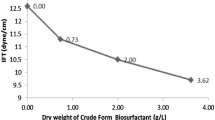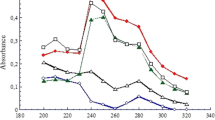Abstract
The aim of this study was to look for high efficient bioflocculant-producing microorganisms. Among 36 bacterial colonies isolated from a crude petroleum oil sample, three of them as Bacillus subtilis and Pseudomonas spp. exhibited flocculation activity exceeding 90 % after 3 days of cultivation. They were identified by 16 S rDNA sequence analysis as Bacillus subtilis and Pseudomonas sp. Spectroscopic analysis of the polymers by nuclear magnetic resonance and fourier-transform infrared revealed that the polymers were glycoproteins. These polymers were soluble in water and insoluble in any organic solvents tested. The effects of bioflocculant dosage, temperature and pH on the flocculation activity were evaluated. The maximum bioflocculation activities were observed at an optimum bioflocculant dosage of 3.5 mg/L (strains Bacillus subtilis and Pseudomonas) and 5.0 mg/L (strain CPO14), respectively. In addition, these biopolymers were able to flocculate kaolin suspension (5 g/L) over a wide range of pH (pH 3–9) and temperature (5–50 °C) tested in the presence of CaCl2. The highest flocculation activities of strains CPO8, CPO13 and CPO14 were 96.03 %, 92.17 % and 97.59 %, respectively in the early stationary phase (at 24 h), while the cell production reached its maximum in the stationary phase (at 72 h). Their efficient flocculation capabilities suggest potential applications in industries.
Similar content being viewed by others
References
Abd-El-Haleem, D.; Al-Thani, R.; Al-Mokemy, T.; Al-Marii, S.; Hassan, F., (2008). Isolation and characterization of extracellular bioflocculants produced by bacteria isolated from Qatari Ecosystems. Pol. J. Microbiol., 57(3), 231–239 (9 pages).
Al-Thani, R.; Abd-El-Haleem, D.; Al-Shammri, M., (2009). Isolation and characterization of polyaromatic hydrocarbons-degrading bacteria from different qatari soils. Afr. J. Microbiol. Res., 3(11), 761–766 (6 pages).
Besra, L.; Sengupta, D. K.; Roy, S. K.; Ay, P., (2003). Influence of surfactants on flocculation and dewatering of kaolin suspensions by cationic Polyacrylamide (PAM-C) flocculant. Sep. Purif. Tech., 30(3), 251–264 (14 pages).
Bradford, M. M., (1976). A rapid and sensitive method for the quantitation of microgram quantities of protein utilizing the principle of proteindye binding. Analys. Biochem., 72, 248–254 (5 pages).
Chaplin, M. F.; Kennedy, J. F., (1994). Carbohydrate Analysis, seconded. Oxford University Press, New York, pp. 138–141 (4 pages).
Collins, E. A.; Bares, J.; Billmeyer, F. W., (1973). Experiments in Polymer Science. New York: Wiley, pp. 125–130 (6 pages).
De-Beer, T.; van-Zuylen, C. W. E. M.; HaÊ, K.; Boelens, R.; Kaptein, R.; Kamerling, J. P.; Vliegenthart, J. F. G., (1994). Rapid and simple approach for the NMR resonance assignment of the carbohydrate chains of an intact glycoprotein. FEBS Lett., 348(1), 1–6 (6 pages).
Deng, S. B.; Bai, R. B.; Hu, X. M.; Luo, Q., (2003). Characteristics of a bioflocculant produced by Bacillus mucilaginosus and its use in starch wastewater treatment. Appl. Microbiol. Biotech., 60(5), 588–593 (6 pages).
Dermlim, W.; Prasertsan, P.; Doelle, H., (1999). Screening and characterization of bioflocculant produced by isolated Klebsiella sp. Appl. Microbiol. Biotech., 52(5), 698–703 (6 pages).
Divakaran, R.; Sivasankara, V. N., (2001). Flocculation of kaolinite suspensions in water by chitosan. Water Res., 35(16), 3904–3908 (5 pages).
Faust, S. D.; Aly, O. M., (1983). Removal of particulate matter by coagulation. In Chemistry of Water Treatment, Butterworth Publishers, Boston, pp. 277–367 (91 pages).
Francy, D. S.; Thomas, J. M.; Raymond, R. L.; Ward, C. H., (1991 ). Emulsification of hydrocarbons by subsurface bacteria. J. Ind. Microbiol., 8(4), 237–246 (10 pages).
Ganesh Kumar, C.; Joo, H. S.; Choi, J. W.; Koo, Y. M.; Chang, C. S., (2004). Purification and characterization of an extracellular polysaccharide from haloalkalophilic Bacillus sp. I-450. Enzyme Microb. Tech., 34(7), 673–681 (9 pages).
Gong, W. X.; Wang, S. G.; Sun, X. F.; Liu, X. W.; Yue, Q. Y.; Gao, B. Y., (2008). Bioflocculant production by culture of Serratia ficaria and its application in wastewater treatment. Bioresour. Tech., 99(11), 4668–4674 (7 pages).
Kim, L. S.; Hong, S. J.; Son, M. K.; Lee, Y. H., (2006). Polymeric and compositional properties of novel extracellular microbial polyglucosamine biopolymer from new strain of Citrobacter sp. BL-4. Biotech. Lett., 28(4), 241–245. (5 pages)
Kumar, C. G.; Joo, H. S.; Choi, J. W., (2004). Purification and characterization of an extracellular polysaccharide from haloalkalophilic Bacillus sp. I-450[J]. Enzyme Microb. Tech., 34(7), 673–681 (9 pages).
Kurane, R.; Nohata, Y., (1991). Microbial flocculation of waste liquids and oil emulsions by a bioflocculant from Alcaligenes latus. Agr. Biol. Chem., 55(4), 1127–1129. (3 pages)
Kurane, R.; Takeda, K.; Suzuki, T., (1986). Screening for characteristics of microbial flocculants. Agr. Biol. Chem., 50, 2301–2307 (7 pages).
Kwon, G. S.; Moon, S. H.; Hong, S. D.; Lee, H. M.; Kim, H. S.; Oh, H. M., (1996). A novel flocculant biopolymer produced by Pestalotiopsis sp. KCTC 8637P. Biotech. Lett., 18(12), 1459–1464 (6 pages).
Lee, S. H.; Lee, S. O.; Jang, K. L.; Lee, T. H., (1995). Microbial flocculant from Arcuadendron sp. TS-49. Biotech. Lett., 17(1), 95–100 (6 pages).
Liu, W.; Wang, K.; Li, B.; Yuan, H.; Yang, J., (2010). Production and characterization of an intracellular bioflocculant by Chryseobacterium daeguense W6 cultured in low nutrition medium. Biores. Tech., 101(3), 1044–1048 (5 pages).
Liu, W.; Yuan, H; Yang, J.; Li, B., (2009). Characterization of bioflocculants from biologically aerated filter backwashed sludge and its application in dying wastewater treatment. Biores. Tech., 100(9), 2629–2632 (4 pages).
Lu, W.; Zhang, T.; Zhang, D.; Li, C.; Wen, J.; Du, L., (2005). A bioflocculant produced by Enterobacter aerogenes and its use in defecating the trona suspension. Biochem. Eng. J., 27(1), 1–7 (7 pages).
Murray, E.; Doetsch R. N.; Robinow, C. F., (1994). Determinative and cytological light microscopy. In: Gerhardt P, Murray RGE, Wood WA, Krieg NR (eds) Methods for general and molecular bacteriology. American Society for Microbiology, Washington, DC, pp 21–41 (21 pages).
Rossini, M.; Garcia, J.; Galluzzo, M., (1999). Optimization of the coagulation-flocculation treatment: influence of rapid mix parameters. Water Res., 33(8), 1817–1826 (10 pages).
Salehizadeh, H.; Shojaosadati, S. A., (2001). Extracellular biopolymeric flocculants: Recent trends and biotechnological importance. Biotech. Adv., 19(5), 371–385 (25 pages).
Shih, I. L.; Van, Y. T.; Yeh, L. C., (2001). Production of a biopolymer flocculant from Bacillus licheniformis and its flocculation properties. Bioresour. Tech., 78(3), 267–272 (6 pages).
Stauber, J. L.; Florence, T. M.; Davies, C. M.; Adams, M. S.; Buchanan, S. J., (1999). Bioavailability of Al in alum treated drinking water. J. Am. Water Works Assoc., 91(11), 84–93 (10 pages).
Takagi, H.; Kadowaki, K., (1985). Flocculant production by Paecilomyces sp.: taxonomic studies and culture condition for production. Agr. Biol. Chem., 49, 3151–3157 (7 pages).
Xia, S. Q.; Zhang, Z. Q.; Wang, X. J.; Yang, A.; Chen, L.; Zhao, J. F.; Leonard, D.;Jaffrezic-Renault, N., (2008). Production and characterization of a bioflocculant by Proteus mirabilis TJ-1. Bioresour. Tech., 99(14), 6520–6527 (8 pages).
Xiong, Y.; Wang, Y.; Yu, Y.; Li, Q.; Wang, H.; Chen, R.; He, N., (2010). Production and characterization of a novel bioflocculant from Bacillus licheniformis. Appl. Environ. Microbiol., 76(9), 2778–2782 (5 pages).
Yin, H.; Qiang, J.; Jia, Y.; Ye, J.; Peng, H.; Qin, H.; Zhang, N.; He, B., (2009). Characteristics of biosurfactant produced by Pseudomonas aeruginosa S6 isolated from oil-containing wastewater. Process Biochem., 44(3), 302–308 (7 pages).
Yokoi, H.; Natsuda, O.; Hirose, J.; Hayashi, S.; Takasaka, Y., (1995). Characteristics of a biopolymer flocculant produced by Bacillus sp. PY-90. J. Ferment. Bioeng., 79(4), 378–380 (3 pages).
Yokoi, H.; Yoshida, T.; Mori, S.; Hirose, J.; Hayashi, S.; Takasaki, Y., (1997). Biopolymer flocculant produced by an Enterobacter sp. Biotech. Lett., 19(6), 569–573 (5 pages).
Yong, P.; Bo, S.; Yu, Z., (2009). Research on flocculation property of bioflocculant PG.a21 Ca. Mod. Appl. Sci., 3(6), 106–112 (7 pages).
Zhang, Z. Q.; Lin, B.; Xia, S. Q.; Wang, X. J.; Yang, A. M., (2007). Production and application of a novel bioflocculant by multiple-microorganism consortia using brewery wastewater as carbon source. J. Environ. Sci. China., 19(6), 667–673 (7 pages).
Author information
Authors and Affiliations
Rights and permissions
About this article
Cite this article
Zaki, S., Farag, S., Elreesh, G.A. et al. Characterization of bioflocculants produced by bacteria isolated from crude petroleum oil. Int. J. Environ. Sci. Technol. 8, 831–840 (2011). https://doi.org/10.1007/BF03326266
Received:
Revised:
Accepted:
Published:
Issue Date:
DOI: https://doi.org/10.1007/BF03326266




